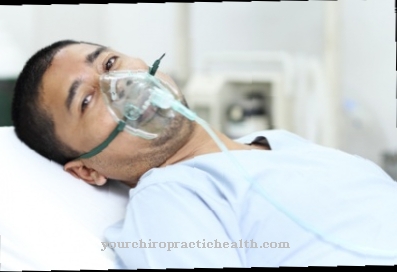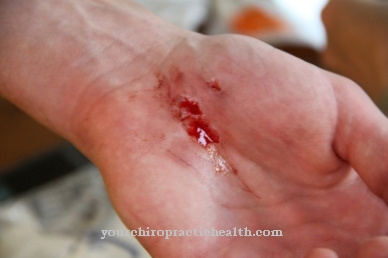Facial pain have different forms and causes. If the cause of facial pain cannot be combated, the symptoms can be combated.
What is facial pain?

Facial pain is a painful sensation that can affect different parts of the face. Facial pain can occur in the jaw, cheeks, temples, as well as in the areas of the nose, mouth and ears. Muscles and facial skin can also be affected by facial pain.
In medicine, different forms of facial pain are distinguished; The most common facial pain includes the so-called trigeminal neuralgia (affecting the facial nerves) or idiopathic facial pain. Facial pain associated with trigeminal neuralgia is usually described by those affected as flashing and sharp.
Facial pain is also categorized according to the regions of the face in which it occurs and whether it is chronic (i.e. long-lasting) or acute. With regard to the cause of facial pain, a distinction can be made between symptomatic pain (with known causes) and idiopathic pain (without known causes).
causes
Just as diverse as the forms of facial pain are possible underlying causes. In the context of trigeminal neuralgia, for example, facial pain comes from the so-called trigeminal nerve (also known as the trigeminal nerve).
Mostly facial pain in such a trigeminal neuralgia is caused by damage to the corresponding nerve. Neuralgia facial pain can be caused by other physical illnesses; however, a cause cannot always be determined.
Other causes that can cause various facial pains are, for example, diseases such as facial or shingles or impairment of the jaw and / or masticatory muscles. In addition, facial pain can be caused by sinus disease or impairment of the neck and shoulder.
Often, causes of facial pain can also be found in the head area of an affected person; for example, brain tumors or strokes can lead to facial pain.
You can find your medication here
➔ Medicines for painDiseases with this symptom
- Shingles
- Trigeminal neuralgia
- Sinus mucocele
- Brain tumor
- Atypical facial pain
- Sinus inflammation
- stroke
- Bruised eyeball
- Root inflammation
Diagnosis & course
The condition of facial pain is usually first diagnosed by the treating doctor on the basis of the patient's description of the symptoms. Diagnostically important information on occurring facial pain relates to a patient's medical history and a precise description of the times and severity of the facial pain.
For example, facial pain can turn out to be a burst-wise response to various stimuli or persistent pain. Depending on the nature of the facial pain, a diagnosis may require the consultation of various specialists; However, it is not always possible to precisely diagnose the cause of facial pain.
The course of facial pain depends primarily on the underlying causes of the pain. If the causes of facial pain can be diagnosed and remedied, the associated pain usually also subsides.
Complications
The possible complications of facial pain are many. The pain can develop into chronic complaints and, as the process progresses, severely strain the nerves in the affected area. In addition to the pain itself, there is tension and often numbness in the chin and cheeks. Pain patients often have a long path of suffering behind them, which is associated with a decrease in quality of life.
Misdiagnoses are just as problematic: in the search for the cause, healthy tooth roots may be treated or the sinuses operated on, along with other therapeutic measures, which, due to the misdiagnosis, can aggravate the symptoms. Chronic facial pain often develops into depressive moods and even full-blown depression. Taking pain medication can damage the organs and, depending on the drug, lead to some other complications. Facial pain occurs predominantly during the day and is particularly stressful for those affected in everyday life.
Stress, listlessness and the fear of further pain attacks are the result. Other complications: overheating, numbness and an unpleasant tingling sensation in the painful area. The intensity and occurrence of complications depend on the cause of the facial pain, the medication, and the environment. The condition worsens through stress and a change in the weather can intensify the problems. An early clarification by a doctor is therefore advisable.
When should you go to the doctor?
Facial pain leads to high levels of suffering in those affected. They occur in many areas: temples, cheeks, jaw, mouth, nose, and ears. When it comes to facial pain, there is hardly any question of whether or not to see the doctor. The event is too painful. The first point of contact should be the family doctor. He may refer his patient to a neurologist, internist, ear, nose and throat doctor, orthopedic surgeon or orthodontist. Other options would be the dentist as well as a psychologist or psychotherapist.
Trigeminal neuralgia and other neuralgia are known for facial pain. Facial pain is often triggered by insufficient function of the masticatory muscles or the jaw. Colds, including sinus diseases, are another common cause of facial pain.
Occasionally they are based on referred pain from the neck or shoulder area. Herpes zoster diseases such as shingles and facial roses are also often expressed in the affected areas with pain. In older people in particular, it is not uncommon for the unpleasant so-called postherpetic zoster neuralgia to occur following a herpes disease on the face.
The possibility of a brain tumor, stroke, or multiple sclerosis should always be considered when making a diagnosis of facial pain. When diagnosing facial pain, it is important to distinguish it from headache.
Doctors & therapists in your area
Treatment & Therapy
As with the course of facial pain, successful pain management is closely related to the causative factors of facial pain.
As far as possible, therapeutic measures to combat facial pain are initially aimed at eliminating the causes of pain. Depending on the cause, different specialists can be responsible for eliminating the cause of facial pain. In some cases it is also possible to counteract facial pain through surgical interventions, but experts recommend detailed consultations first.
If the causes of facial pain cannot be discovered and thus treated, or if the facial pain is based on chronic illnesses that cannot be cured, possible treatment measures are symptomatic therapy (pain relief). Facial pain caused by impairment of the facial nerves can often be reduced with the use of pain reliever medication.
If there is chronic facial pain, patients can learn how to deal with facial pain in special pain clinics, for example. Outpatient psychotherapy procedures can also provide patients with strategies to help them cope with facial pain; These strategies can include, for example, various relaxation methods.
Outlook & forecast
Whether the facial pain will heal or whether it is associated with certain complications cannot be universally predicted. Treatment depends heavily on the causes of the facial pain. As a rule, facial pain can always be limited with the help of medication. However, the patient should not take pain relievers for long periods of time as they can have a negative effect on the stomach.
In a few cases, the facial pain can also be treated with a surgical procedure. This is often the case when the jaw or oral cavity causes pain and normal everyday life is no longer possible.
If the facial pain is left untreated, it will significantly reduce the quality of life. The affected person can no longer lead a normal everyday life and is very limited in his activities. Therefore, sufferers should always try to reduce stress and relax a lot to prevent facial pain.
You can find your medication here
➔ Medicines for painprevention
If the first facial pain occurs, a quick diagnosis and subsequent therapy can help prevent the pain from worsening. In order to prevent chronic facial pain from worsening, experts recommend measures such as a healthy lifestyle: factors such as regular physical activity, reducing stress and a moderate consumption of alcohol and nicotine should help to strengthen the psyche and body with facial pain.
You can do that yourself
Unfortunately, it cannot be universally predicted whether facial pain can be treated through self-help and therapy without a doctor. In many cases, however, treatment with medication or surgery is necessary to reduce facial pain.
In any case, a healthy lifestyle with a healthy diet and lots of physical activity has a positive effect on the health of the entire body. This can also have a positive effect on facial pain. However, the patient should keep in mind that the success of changing diet and taking up exercise does not appear immediately, but takes several weeks or months before it can be recognized. Patience is therefore required above all.
Very often the facial pain arises from stress and unnecessary physical and psychological stress. The affected person should escape these in any case, as they only aggravate the facial pain and thus delay healing. In this case the body needs a lot of relaxation and must not be strained unnecessarily. In acute cases, something as mundane as cooling can provide relief.
However, if the facial pain persists and does not improve with these self-help methods, a doctor must be consulted.





.jpg)


















.jpg)



